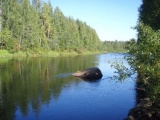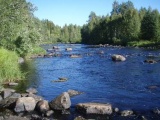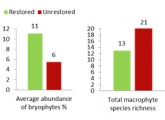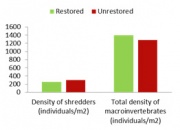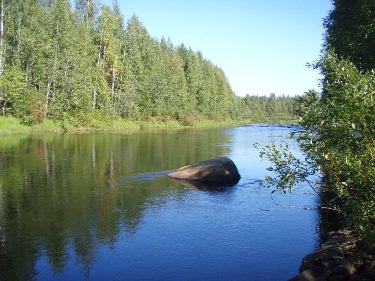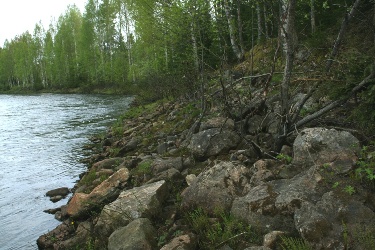KUIVAJOKI
KUIVAJOKI
Site description
River Kuivajoki is a mid-sized lowland boreal river, with 970 km2 catchment area. The river is 46 km long and descends 89 metres from Lake Oijärvi to Bothnian Bay, northern part of the Baltic Sea. The river is included in the Salmon Action Plan by International Baltic Sea Fishery Commission aiming to re-establish wild salmon population in the river. Kuivajoki is protected from hydropower construction by the Finnish Act on the protection of rapids.
Fast-flowing riffle sections in Kuivajoki, as in most other Finnish rivers, were channelized to facilitate timber transport and for flood protection in early 1900s. Channelisation included removing boulders from the channel which lead to loss of habitats and decreased heterogenity in stream flow patterns. These boulders were placed along the river banks where they are still present. Last timber was transported in Kuivajoki in 1954. Furthermore, water quality of the river is deteriorated due to human activities in the catchment. The main pressures in are peat mining, forestry and agriculture and municipal point sources.
Kuivajoki was chosen as a REFORM case study because it is among the few rivers in Finland that still had non-restored degraded upstream control sites to meet the study design of REFORM WP4 (REFORM deliverable D4.3 ). Kalliokoski is one of the channelized riffle sites and it is the non-restored degraded control site in WP4 case study (see photo below). Hirvaskoski is one of the riffle sections in River Kuivajoki where restoration measures were conducted and it is the restored site in WP4 case study (see photo below).
Measures selection
In Kuivajoki, altogether about 5 km of the river (consisting of multiple riffle sections in the river) were restored in early 2000s. The stream bottom was rearranged using boulders that formerly were removed from the channel and placed along stream margins during channelization. Also gravel beds were created to provide nursery habitat for salmonids. The funding for the restorations came from regional water boards.
Furthermore, the regulation of Lake Oijärvi has been developed to prevent the drying of the natural stream at upper parts of Kuivajoki (where Oijärvi flows to Kuivajoki) and to enable the migration of fish at all water levels.
Success criteria
The goals were to return the natural current conditions and morphology of the stream and to enable breeding and migration of salmonid fish.
Ecological response
Electrofishing was done at Kuivajoki at 13 sites in 2003 after the restorations. Both salmon (Salmo salar, frequency 10/13) and grayling (Thymallus thymallus, frequency 7/13) were caught. However, all salmon individuals were older than one year and the age class 0+ was missing which indicates that natural breeding may not happen. The catch had also perch (Perca fluviatilis, frequency 9/13) and roach (Rutilus rutilus, frequency 4/13). The fish showed good quality class in 2003. The results in 2003 were similar to results from previous years 1999-2007. In 2006-2009, 28 fish sites were monitored. The monitoring indicated good status of the fish communities and no change to the previous results (EQR = 0,77).
Macroinvertebrates from restored Hirvaskoski and Soininkoski were assessed to reach the good ecological status 2006. Based on the samples taken in 2009 and 2012, Hirvaskoski even reached the high ecological status ( EQR = 0,843). Moreover, periphyton indicated a good ecological status in 2006-2012 (EQR 0,67).
The ecological effects of restoration was also evaluated in the REFORM project by comparing the biological communities of the upstream unrestored and restored reach. For macrophytes, especially bryophyte abundance was higher in the restored section (see figure below), which are important for the functioning of boreal streams because they provide habitats for other biota, trap sediment and serve as a feeding area for aquatic insects. However, total species richness of macrophytes was lower in the restored section. Macroinvertebrates showed no clear differences between the restored and unrestored sections (see figure below).
Water quality response
After the restorations (period 2000-2007) total phosphorus concentration, minimum pH and total nitrogen indicated good status. In 2006-2012 total phosphorus indicated a moderate status, whereas minimum pH and nitrogen indicated good class. Water quality is degraded likely by eight peat mining areas and a wastewater treatment plant.
Hydromorphological response
The effect of restoration on hydromorphology was assessed at different spatial scales in the REFORM project to investigate if restoring macroscale channel featurs also increases habitat diversity at the meso- and microscale. Compared to the unrestored site, the restored site was spatially more diverse at the micro- and mesoscale: the restored site had more variation in dominant substrates, flow velocity and in depth. Moreover, the restored site was also more natural in resepct to the flow patterns, channel geometry, and connectivity.
Monitoring before and after implementation of the project
Before-after monitoring of the restoration success was not done. However, assessment of the ecological and water quality status of River Kuivajoki has been done after the restorations.
Socio-economic aspects
No information found.
Contact person within the organization
Finnish Environmental Institute, Freshwater Centre
Jukka Aroviita
E-mail: jukka.aroviita@ymparisto.fi
Extra background information
References
Aronsuu K. & Isid D. 2010. Pohjois-Pohjanmaan jokien hydrologis-morfologiset muutokset sekä mahdolliset hydrologiaan ja morfologiaan vaikuttavat toimenpiteet jokien ekologisen tilan parantamiseksi, www.ymparisto.fi/oulujoen-iijoenvesienhoitoalue
The Finnish Environmental Information: Hertta database.
Vesien kunnostustyöryhmä. 2012. Vesien kunnostustyöryhmän loppuraportti.
http://www.hare.vn.fi/mAsiakirjojenSelailu.asp?h_iId=16574&a_iId=180254
Related Measures
- Improve water retention
- Add/feed sediment
- Ensure minimum flows
- Establish environmental flows / naturalise flow regimes
- Shallow water courses
- Add sediments
- Initiate natural channel dynamics to promote natural regeneration
- Reduce impact of dredging
- Recreate gravel bar and riffles
- Lower river banks or floodplains to enlarge inundation and flooding
- Other measures
Related Pressures
- Sediment discharge from dredging
- Hydrological regime modification
- Artificial barriers upstream from the site
- Alteration of instream habitat
- Embankments, levees or dikes
- Loss of vertical connectivity
- Impoundment
- Channelisation / cross section alteration
Drivers, Pressures, Measures
Fast-flowing riffle sections in Kuivajoki, as in most other Finnish rivers, were channelized to facilitate timber transport and for flood protection in early 1900s. Channelisation included removing boulders from the channel (Picture 3) which lead to loss of habitats and decreased heterogenity in stream flow patterns. Last timber was transported in Kuivajoki in 1954.
Restoration of channelised riffle sectionss started in Finland in 1970´s. Since then in total 2000 riffles and 1000 and breeding sites have been restored. The goals were to return the natural morphology of the streams and to create natural current conditions especially to enable breeding and migration of salmonid fish.
In Kuivajoki, altogether about 5 km of the river (consisting of multiple riffle sections in the river) were restored in early 2000s. The stream bottom was rearranged using boulders were removed from the channel and placed along stream margins during channelization. Also gravel beds were created to provide nursery habitat for salmonids. The funding for the restorations came from regional water boards.
Also the regulation of Lake Oijärvi has been developed to prevent the drying of the natural stream at upper parts of Kuivajoki (where Oijärvi flows to Kuivajoki) and to enable the migration of fish at all water levels.
Riffles in upper part of Kuivajoki river are still channelized. Kuivajoki was chosen as a REFORM case study because it is among the few rivers in Finland that still had non-restored degraded upstream control sites to meet the study design of REFORM WP4. Kalliokoski is one of the channelized riffle sites and it is the non-restored degraded control site in WP4 case study (Picture 2). Hirvaskoski is one of the riffle sections in River Kuivajoki where restoration measures were conducted and it is the restored site in WP4 case study (Picture 1).
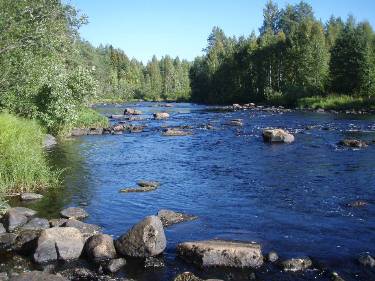 The restored riffle section Hirvaskoski at River Kuivajoki. Most of the boulders that were removed from the river during channelisation were placed back in early 2000s to create more heterogenous habitat for the stream biota.
The restored riffle section Hirvaskoski at River Kuivajoki. Most of the boulders that were removed from the river during channelisation were placed back in early 2000s to create more heterogenous habitat for the stream biota.
The non-restored riffles lack heterogenous flow pattern of the natural riffle sections.
During channelisation for timber transport boulders were removed from the river channel and placed at the banks where they still remain (photo from non-restored Hirvaskoski 2012).
Measures selection
Information can be found under "site description".
Success criteria
No information found.
Ecological response
Electrofishing was done at Kuivajoki at 13 sites in 2003 after the restorations. Both salmon (Salmo salar, frequency 10/13) and grayling (Thymallus thymallus, frequency 7/13) were caught. However, all salmon individuals were older than one year and the age class 0+ was missing which indicates that natural breeding may not happen. The catch had also perch (Perca fluviatilis, frequency 9/13) and roach (Rutilus rutilus, frequency 4/13). The fish showed good quality class in 2003. The results in 2003 were similar to results from years 1999-2007. In 2006-2009 28 fish sites were monitored. The monitoring indicated good status of the fish communities and no change to the previous results (EQR = 0,77). Macroinvertebrates from restored Hirvaskoski and Soininkoski were assessed to be in good quality class in 2006. Based on samples 2009 and 2012 Hirvaskoski was placed in status class high ( EQR = 0,843). Also periphyton indicated good quality status in 2006-2012 (EQR 0,67).
Water quality response
After the restorations (period 2000-2007) total phosphorus concentration, minimum pH and total nitrogen indicated good status. In 2006-2012 total phosphorus indicated moderate status, whereas minimum pH and nitrogen indicated good class. Water quality is degraded likely by eight peat mining areas and a wastewater treatment plant.
Hydromorphological response
No information found.
Monitoring before and after implementation of the project
Before-after monitoring of the restoration success was not done. However, assessment of the ecological and water quality status of River Kuivajoki has been done after the restorations.
Socio-economic aspects
No information found.
Contact person within the organization
Finnish Environmental Institute, Freshwater Centre
Jukka Aroviita
E-mail: jukka.aroviita@ymparisto.fi
Extra background information
References
Aronsuu K. & Isid D. 2010. Pohjois-Pohjanmaan jokien hydrologis-morfologiset muutokset sekä mahdolliset hydrologiaan ja morfologiaan vaikuttavat toimenpiteet jokien ekologisen tilan parantamiseksi, www.ymparisto.fi/oulujoen-iijoenvesienhoitoalue
The Finnish Environmental Information: Hertta database.
Vesien kunnostustyöryhmä. 2012. Vesien kunnostustyöryhmän loppuraportti.
http://www.hare.vn.fi/mAsiakirjojenSelailu.asp?h_iId=16574&a_iId=180254
Related Measures
- Improve water retention
- Add/feed sediment
- Ensure minimum flows
- Establish environmental flows / naturalise flow regimes
- Shallow water courses
- Add sediments
- Initiate natural channel dynamics to promote natural regeneration
- Reduce impact of dredging
- Recreate gravel bar and riffles
- Lower river banks or floodplains to enlarge inundation and flooding
- Other measures
